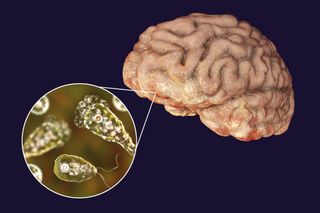2023 was the hottest summer over the last 2,000 yearsand summer 2024 looks like just as intenseAs summer reaches its peak, lakes and freshwater pools across the United States will likely be filled with people trying to cool off. temperatures of these freshwater environments When waters rise, organisms living in them can move, posing a dangerous or even deadly threat to swimmers.
Naegleria fowleri is one of those threats that seems poised to infect more people — but surprisingly, it hasn’t yet.
N. fowleri is a single-celled organism that likes warm temperatures, lives in soil and fresh water, and feeds on bacteria, like many others of its kind. The amoeba can hide in lakes, rivers, hot springs, well water, tap water and poorly maintained swimming pools, among others other water sources.
The scary thing about this tiny organism is that it can enter the brain via the nerves in the nose and then decimate brain cells. This rare infection can lead to a deadly disease called primary amoebic meningoencephalitis (PAM), which is why N. fowleri is commonly referred to as the “brain-eating amoeba.”
Related: Rare ‘brain-eating’ amoeba infection kills 2-year-old in Nevada
N. fowleri infections that lead to PAM are relatively rare in the United States, with an average of zero to eight laboratory-confirmed cases per year. Although all PAM incidents are caused by a N. fowleri infection, this deadly disorder can sometimes be misdiagnosed as other, more common infections of the nervous system, such as Bacterial meningitis And viral encephalitisSuch misdiagnoses may mean that some cases of PAM go undetected.
Symptoms of PAM Symptoms typically begin between one and twelve days after a person is exposed to the amoeba, and patients die between one and eighteen days after symptoms appear. N. fowleri Infection is also a slow process, further complicating diagnosis, and there are no specific drugs to kill the amoeba.
Historically, diagnosed N. fowleri Infections have been concentrated in warmer southern states. In recent years, however, the amoeba has been detected — and even caused infections — farther north, including in Iowa, Nebraska And Minnesota. The reason behind it’s climate change.
Infections observed in northern latitudes have Researchers worried that warming temperatures could do N. fowleri more frequent infections.
Leigh Stahlfaculty member at the University of Alabama, recently published working to determine how changes in the environment affect the growth of N. fowleri populations. Stahl discovered that N. fowleri The amoeba can withstand significant temperature changes that other microorganisms in water cannot. This resilience allows the amoeba to outlast its competitors and thus increase its access to resources.
According to Stahl, the amoeba can survive in a wide range of temperatures and acidity levels. It can grow at temperatures as high as 46 degrees Celsius, but it has also been known to thrive at temperatures as low as 26 degrees Celsius.
“It can certainly thrive in a variety of different environments,” Stahl told Live Science. As temperatures in U.S. lakes and rivers rise, either due to global warming or thermal pollution from manufacturers that use water as a coolant, that creates a more conducive environment for the species to thrive. N. fowleri to flourish, she said.
Warming temperatures aren’t the only thing that could help the virus spread. N. fowleriHowever. Stronger and more frequent storms due to climate change can cause local changes in water levels and increase the amount of organic matter that ends up in the water from runoff. This runoff can provide nutrients for organisms in the water, including brain eaters. Not only could storms further spread N. fowleri from land to water, but also alter the levels of other aquatic microorganisms.
Related: Deadly ‘brain-eating’ amoeba successfully treated with repurposed UTI drug

“What you might see are spikes in these organisms after an extreme weather event,” he said. Charles Gerbaprofessor of microbiology and public health at the University of Arizona. “The more nutrients in the water, the more bacteria you’re going to have,” Gerba told Live Science.
“There could be less dissolved oxygen … more blooms of different things … maybe more bacteria,” Stahl added. “And if there’s a greater amount of prey sources in the water, maybe that would allow the N. fowleri eat more or be happier.
Already, massive changes in our freshwater sources have coincided with an increase in the detection of N. fowleri In both southern and northern latitudes, however, there has not yet been a significant increase in confirmed infections with brain-eating amoebae. We still see one or two a year, but why?
The diagnostic difficulties mentioned above N. fowleri Infection could be a factor, meaning cases may simply not be reported. Additionally, Gerba said he believes diagnosis is underreported for other reasons, particularly in northern regions.
“We’re seeing this virus spread more and more in the northern states,” Gerba said. “Some people in Minnesota or Michigan don’t even consider this case as a potential case of infection when they see it, so that’s probably why it’s going under the radar.”
Evidence supports the idea that PAM cases may be underreported due to a lack of expertise among medical staff on this very rare disease, as well as the fact that autopsies are not always performed on deceased patients.
In addition to having more cases in the north, as summer temperatures last longer, “the period in which you will find N. fowleri will increase,” Gerba said. With cases of N. fowleri infections increasing in other countriesExperts are urging American clinicians to become more alert to the signs and to educate the public more about these brain-eating amoebas.
Have you ever wondered why Some people build muscle more easily than others. Or why do freckles appear in the sun? Send us your questions about how the human body works to community@livescience.com with the subject line “Health Desk Q” and you may be able to see the answer to your question on the website!